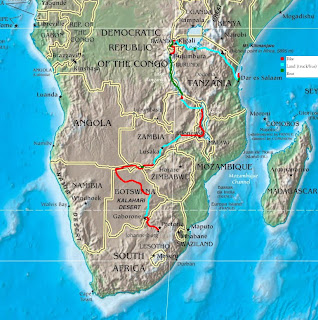We realized that there was no way we had time to bike from Rwanda to the Tanzanian coast and visit Zanzibar in the time we had left, plus there was the small matter of needing to get through the Serengeti (which we weren’t allowed to do on bicycles). Fortunately, the folks I had just been gorilla tracking with had the solution – join them on their overland truck tour that was going exactly where we wanted to go. So we did, and discovered another way to travel in Africa.
http://www.youtube.com/watch?v=aCca5mPMp9A

The following day we drove down into the Ngorongoro crater, which was a bit of a dream world. It’s the largest intact caldera in the world, a volcano that collapsed into itself 2 to 3 million years ago, and fossils show that human-like creatures have been there for pretty much that same length of time. We saw flamingos, male lions for the first time, as well as our first black rhino (sadly all too far away to take decent photos). Seeing a rhino meant that we had now seen all of the “big five”. I hadn’t heard this term before arriving in Africa, but it’s the animals that are most difficult and dangerous to hunt apparently – lion, leopard, elephant, Cape buffalo, and black rhino.
Unfortunately, Nelson didn’t entirely appreciate this as he was quite sick and spent the day alternating between shivering and being boiling hot and extremely exhausted. Fortunately, we were with the overland truck and they organized for him to get to a clinic. I was really grateful that I was able to just take care of Nelson without also having to organize everything else. While we were at the clinic, the guide set up a tent for us, and the group made us dinner, which was really nice. The doctor concluded that Nelson had the flu and a kidney infection and gave him antibiotics but when Nelson wasn’t feeling better a few days later, he started taking malaria medication as well, just in case. We heard from several people who’d had cerebral malaria and almost died from it that the symptoms were fever, chills, and extreme exhaustion and that it doesn’t always show up in tests, so we weren’t taking any chances. We rarely take prescription or even over-the-counter medication at home, so it was interesting to us to see how quick we were to take drugs that we might not even need. Anyhow, back to the trip…
We left the overland truck in Dar Es Salaam and headed over to Zanzibar on a ferry. Known as the Spice Island because of all the spices grown there, it was a really interesting and beautiful place to end our journey. We stayed a night in Stone Town, then biked to the north end of the island where we spent a few days relaxing and playing in the Indian Ocean and Nelson went swimming with turtles.
I’ve included a map of our actual journey, which is pretty similar to our proposed one, with the parts we biked, took busses or trucks, or boated marked in different colours. We ended up biking just over 3000km.
As we talk to people about our trip, and answer questions like “What was your favourite country?”, or “What did you learn?”, or “What were your top three moments?”, we are slowly starting to make sense of our whole journey and what it means to us, so please do keep asking us those questions and others!

